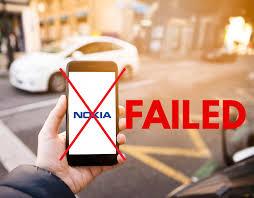For more than a decade, Nokia was a household name in mobile technology. The Finnish company was once the world’s largest mobile phone manufacturer, dominating global markets with its durable devices, long-lasting batteries, and user-friendly design. In the early 2000s, “Nokia” was synonymous with mobile phones—its iconic models like the Nokia 3310 became cultural legends.
However, by the mid-2010s, Nokia’s market share had collapsed, and it was no longer a leader in the mobile industry. In 2014, Nokia sold its handset business to Microsoft, marking the end of an era. The downfall of Nokia is one of the most discussed topics in business and technology circles.
This article will explore why Nokia failed, looking at the company’s history, market position, strategic missteps, technological challenges, and lessons for future businesses.

1. Nokia’s Golden Era (1998–2007)
Before its fall, Nokia enjoyed unmatched dominance:
- Market Leadership: From 1998 to 2008, Nokia was the world’s largest phone manufacturer.
- Innovative Products: Phones like the Nokia 6600, N95, and Communicator series set benchmarks in mobile design and features.
- Brand Trust: Known for durability, long battery life, and wide availability.
- Global Reach: Nokia had manufacturing, R&D, and distribution networks across multiple continents.
This success, however, would later become a double-edged sword. The company’s confidence in its dominance led to complacency, making it slow to react to industry shifts.
2. The Shift to Smartphones
The late 2000s saw a major technological shift in the mobile industry. Apple’s iPhone (2007) and Google’s Android platform (2008) changed the definition of what a phone could be. Smartphones were no longer just communication tools—they became portable computers with touchscreens, advanced internet capabilities, and app ecosystems.
While Nokia had early smartphones running Symbian OS, the platform struggled to adapt to the new touch-based world. Symbian was designed for keypad-based devices and could not match the fluid user experience of iOS and Android.
3. Major Reasons Behind Nokia’s Failure
3.1 Slow Adaptation to Market Changes
Nokia underestimated the touchscreen revolution. Executives believed that physical keypads were superior and that touchscreen devices were just a trend. This miscalculation cost the company valuable time.

3.2 Poor Software Strategy
- Symbian OS became outdated, slow, and complex for developers.
- Nokia tried to modernize Symbian and even introduced MeeGo, but these efforts were late and fragmented.
- Meanwhile, Android’s open-source nature attracted dozens of manufacturers, quickly expanding its market share.
3.3 Weak Ecosystem & App Store
Apple’s App Store and Google’s Play Store became key attractions for users. Nokia’s Ovi Store failed to attract enough developers and lacked competitive apps, making its devices less appealing.
3.4 Internal Management Issues
Reports suggest bureaucratic delays, poor communication between teams, and fear of change within Nokia’s management. Decision-making became slow and risk-averse.
3.5 Partnership Missteps
In 2011, Nokia partnered exclusively with Microsoft to use Windows Phone OS. While the OS was innovative, it had a very small market share compared to Android and iOS, limiting Nokia’s appeal to customers.
3.6 Overconfidence & Brand Image
Nokia believed its brand loyalty would keep customers from switching. However, customers quickly moved to more advanced and user-friendly smartphones from Apple, Samsung, and other Android makers.
4. The Microsoft Acquisition & Further Decline
In 2014, Microsoft acquired Nokia’s handset business for $7.2 billion. However, Windows Phone failed to gain traction, and by 2016, Microsoft stopped developing the platform. Nokia’s once-legendary mobile division was effectively gone from the mainstream smartphone market.
5. Lessons from Nokia’s Failure
- Adapt Quickly to Technological Change – Innovation waits for no one; companies must be ready to pivot.
- Software is as Important as Hardware – A great device needs a strong OS and app ecosystem.
- Customer Needs Come First – Overconfidence in brand loyalty can be dangerous.
- Avoid Overdependence on One Partner – Relying on a single platform (Windows Phone) limited Nokia’s flexibility.
- Encourage Internal Innovation – Big companies must fight bureaucratic slowdowns and support creative teams.

6. Nokia’s Second Life
Interestingly, Nokia has made a comeback—not as a major smartphone leader but as a networking technology giant. The brand name is now licensed to HMD Global, which releases Nokia-branded Android phones. While it’s far from its glory days, Nokia still has loyal fans who remember the durability and reliability of its classic phones.
Conclusion
Nokia’s failure was not caused by a single mistake—it was the result of multiple strategic, technological, and cultural missteps. Its story serves as a reminder that in technology, yesterday’s leader can be tomorrow’s memory if it fails to adapt.
From ruling the mobile world to exiting it, Nokia’s journey is both a warning and an inspiration—proof that even the biggest brands must keep evolving.


 Watch
Watch
 CASUAL WEAR
CASUAL WEAR

